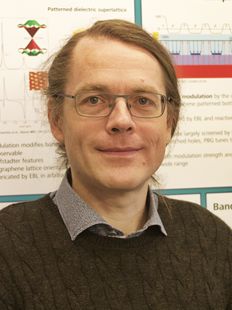Celebrating the Graphene Week 2021 poster winners
Following up on our successful Graphene Week 2021 – the leading event for the Graphene Flagship community – we dedicate a spotlight article to the winners of the poster sessions.
More than 120 posters were presented between 20 and 24 September 2021 and evaluated by 12 experts.
Here we give the floor to poster winners Sonia Freddi and Jonathan Eroms.
Spotlight: Developing gas sensors that detect ammonia

Sonia Freddi - Graphene Week 2021 best poster award
Sonia Freddi is an international PhD student at Graphene Flagship Associated Member Università Cattolica del Sacro Cuore (Italy) under the supervision of Luigi Sangaletti and Catholic University of Leuven (Belgium) in the group of Steven De Feyter.
Why did you decide to work with graphene and layered materials?
Layered materials show unique physical and chemical properties which can be exploited in the chemical gas sensors field. Graphene has attracted particular interest due to its intrinsic properties, including high sensitivity to the surface adsorption of gas molecules, low electrical noise, long-term stability, good surface-to-volume ratio and capability to work at room temperature.
What was your poster about?
I presented my research on the development of graphene-based gas sensors for ammonia detection. Ammonia is the precursor of fine particulates (PM2.5 and PM10), which are very dangerous for human respiratory health. Furthermore, the concentration of ammonia higher than 10 ppb in patient’s exhaled breath can be related to liver or kidney failure.
Sensors with quick response, low energy consumption and fast recovery have been developed, but low-cost sensors, sensitive to the sub-ppm range are harder to devise. Thus, the gas sensor market is challenging physicists, chemists and engineers to develop extremely sensitive, cheap and stable sensors.
In my project, we monitor sensors built with graphene layers that have been successfully modified by using diazonium chemistry with two different functional groups. We build calibration curves for ammonia exposures and observe fast response and quick recovery of the functionalized graphene layers. The sensitivity benchmarking with data reported in literature for graphene chemiresistors shows that our graphene layers display a superior sensitivity in the sub-ppm range.
Furthermore, reproducibility of both sample preparation procedure and sensing capability of the covalently modified sensors have been proven, and the sensing mechanism has been sketched, supported by theoretical calculations.
The results I presented open the possibility to a real application of the sensors in environmental monitoring, food quality tracking or medical screening campaigns, where sensitivity to low ppm concentration, fast response and quick recovery are mandatory.
Which type of applications are you aiming for?
I aim to develop gas sensor platforms for several applications, but mostly for breath analysis (i.e. breathomics), because the current diagnostic methods, such as biopsy, gas chromatography, mass spectroscopy and MRI scan, are often invasive, expensive and can take a long time for the data to be analysed. On the other hand, breathomics holds great promise for the delivery of non-invasive diagnostic tools, since it is based on the fact that the quantity and quality of the volatile organic compounds (VOCs) present in the exhaled breath of healthy patients are different from the ones present in the exhaled breath of sick patients, and each pathology is associated with one or few gas molecules present in a fixed concentration.
What excites you the most about your research project?
What I like the most about my project is the fact that these gas sensors could be used in screening campaigns for selected pathologies, thus it could benefit the community.
What are your plans for the future? Are you going to submit your PhD thesis soon?
The next step of my project will be to test the sensors in patients affected by chronic obstructive pulmonary diseases.
My PhD defence is approaching in a few months and I would like to remain in academia. Therefore, I will start looking for a post-doc position.
Spotlight: Switching on and off graphene’s spin-orbit interaction

Jonathan Eroms - Graphene Week 2021 best poster award
Eroms works at the Graphene Flagship partner University of Regensburg (Germany) as a senior researcher, heading a group that works on graphene-based heterostructures.
Why did you decide to work with graphene and layered materials?
Graphene has fascinated me for over ten years now, as it’s the best approximation to a two-dimensional material in a three (or more...) dimensional world. An extremely broad range of fundamental effects of solid-state physics have been found in graphene: quantum Hall effect, ballistic transport of electrons, superconductivity, spin transport, to name a few. Combining graphene with other 2D materials can endow it with further properties it does not possess by itself, such as strong spin-orbit interaction or magnetism.
What was your poster about?
My work presented on the poster focuses on spin-orbit interaction. This is an effect caused by the theory of relativity: it creates a magnetic field from an electric field, and the electron magnetic moment (spin) can feel this magnetic field. Usually, this property is material-dependent and is very weak in light elements, such as carbon. Because graphene is so thin, its electrons can "inherit" this property from heavy elements nearby, in this case tungsten and selenium atoms. What is special in our experiments is that we can switch spin-orbit interaction on and off with a gate voltage.
Which challenges did you encounter?
Interpreting the data was not easy and required a full theory model. It shows that sometimes the seemingly obvious interpretation is not the correct one.
What are your plans for the future?
I will continue to work in this direction, hopefully including the switchable spin-orbit interaction into a spintronics device, and will also search for proximity-induced magnetism in graphene, brought about by magnetic 2D materials.
Note: The picture on the banner was taken before the COVID-19 pandemic.




 Book your calendar
Book your calendar